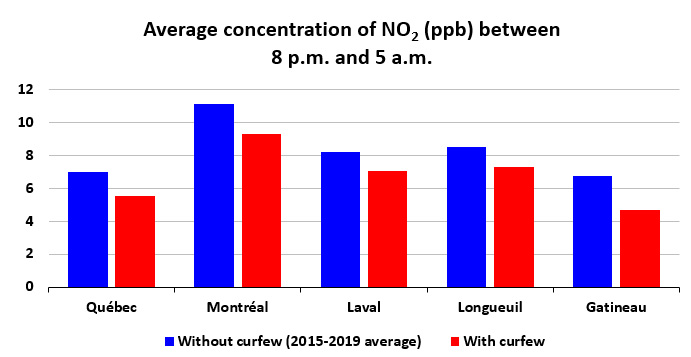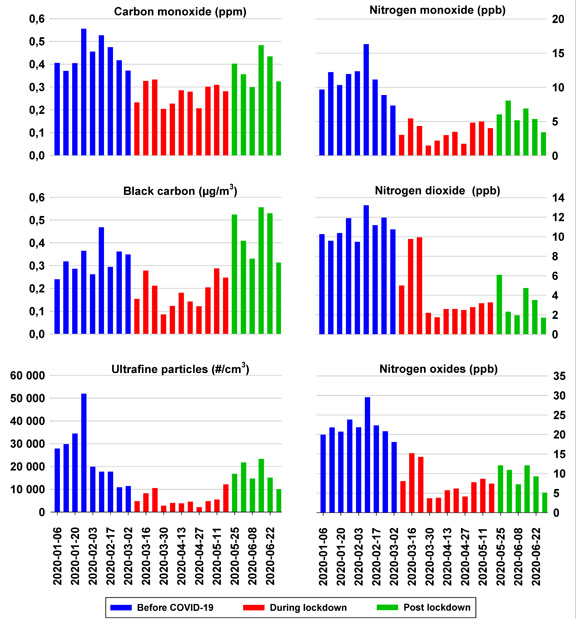Although air quality in Québec is generally good, COVID-19 confinement measures, which have resulted in a decrease in road transportation, have had a positive impact on air quality. Consequently, air concentrations of criteria contaminants associated with road transportation have decreased.
The Henri-IV highway in Québec City as an example
A monitoring station alongside the Henri-IV highway in Québec City assesses the impact of road transportation on ambient air quality . The station is equipped with a radar instrument that counts the number of vehicles on the highway.
During the first lockdown, from March 13 to April 24, 2020, highway traffic greatly diminished during the first weeks while subsequently and progressively returning to levels that were comparable to previously observed values. At the high point of the lockdown measures, the number of vehicles on the Henri-IV highway dropped by 60% from 500,000 to 200,000.
Several contaminants associated with road transportation can affect air quality. Some of them have decreased during the lockdown, the main changes being as follows:
- Black carbon: - 45%
- Nitrogen monoxide: - 65%
- Nitrogen dioxide: - 60%
- Nitrogen oxides: - 60%
- Carbon monoxide: - 35%
- Ultrafine particulate matter (PM0.1): -80%
The following figure shows the weekly concentrations of these contaminants.
The following figure illustrates the average concentrations of nitrogen monoxide (NO) measured at the Henri-IV station from Monday to Friday, based on the time of day.

As shown in the above two illustrations, the post-lockdown concentrations of nitrogen oxides were lower than they were prior to the outbreak of COVID-19. This situation is normal and not the result of lower highway traffic, but rather due to the natural ozone cycle and ultraviolet (UV) radiation. It turns out that the end of the lockdown coincided with the time of the year when ozone concentrations are higher. Ozone reacts rapidly with NO when the two gases are in contact, forming nitrogen dioxide (NO2). Additionally, UV radiation in turn reacts with NO2, creating ozone, which in the end lowers the concentrations of NOX.
Concentrations of other contaminants measured at the Henri-IV station, including, sulphur dioxide (SO2) and fine particulate matter (PM2.5), fluctuated less during the lockdown since they to a greater extent come from sources other than transportation, such as industry and wood heating.
Air quality monitoring elsewhere in Québec
The decrease in road traffic also appears to have had a positive impact on air quality elsewhere in Québec. The following figure illustrates the average weekly concentrations of nitrogen dioxide (NO2), another contaminant associated with road transportation, in parts per billion (ppb) in urban areas in Québec during the first lockdown period.
During the pandemic, Québec experienced lockdown episodes. The first three affected Québec from:
- March 13 to April 24, 2020;
- December 25, 2020 to March 7, 2020;
- April 1, 2021 to May 28, 2021.
Statistical analysis made it possible to calculate the drop in NO2 concentrations in ambient air attributable to these three lockdowns due to COVID-19. The lockdown from December 20, 2021 to January 17, 2022 cannot be compared to the previous episodes, since the measures were implemented gradually.

Each of the three episodes caused significant declines in urban areas, but the first is the one that had the greatest impact. The declines of the second and third lockdowns are 40 to 50% lower than those of the first lockdown. The different levels observed in Gatineau can be explained by the fact that the health measures differed from those of its Ontario neighbour, Ottawa.
The impact of the curfew
During the second and third lockdown periods, the Québec population was subject to a curfew from 8 p.m. to 5 a.m. This restriction had a positive impact on urban air quality. The following figure shows that NO2 concentrations between 8 p.m. and 5 a.m. decreased compared to the average of the last five years.

To learn more
To learn more about air quality in Québec, go to the webpage of the Québec air quality monitoring network.
To get real-time information on air quality in your region, go to the Air Quality Index site .
Last update: February 23, 2023





